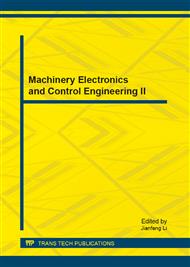[1]
G.B. Hobbs, R.T. Edwards and R.N. Manchester: TEMPO2, a New Pulsar-timing Package – I. An Overview, Mon. Not. R. Astron. Soc., 369 (2006), p.655–672
DOI: 10.1111/j.1365-2966.2006.10302.x
Google Scholar
[2]
G. Petit and B. Luzum: IERS Conventions 2010, IERS Technical Note, No. 36, 2010, available on http://www.iers.org
DOI: 10.1017/s1743921314005535
Google Scholar
[3]
W. Harada and T. Fukushima: Harmonic Decomposition of Time Ephemeris TE405, Astron. J., 126(5) (2003), pp.2557-2561
DOI: 10.1086/378909
Google Scholar
[4]
The SOFA Software Collection, 2012, available on http://iau-sofa.hmnao.com
Google Scholar
[5]
The EOP and Space Weather Data, 2012, availabe on http://www.celestrak.com/SpaceData
Google Scholar
[6]
T. Damour and N. Deruelle: General Relativistic Celestial Mechanics II. The Post-Newtonian Timing Formula, Ann. Inst. H Poincaré (Physicque théorique), 44 (1986), p.263–292
Google Scholar
[7]
L.W. Huang, B. Liang and T. Zhang: Pulse Phase and Doppler Frequency Estimation of X-ray Pulsars under Conditions of Spacecraft and Binary Motion and its Application in Navigation, Sci. China Ser. G-Phys. Mech. Astron. (2012), in press
DOI: 10.1007/s11433-013-5001-0
Google Scholar
[8]
L.W. Huang, B. Liang, T. Zhang, et al.: Navigation Using Binary Pulsars, Sci. China Ser. G-Phys. Mech. Astron., 55(3) (2012), p.527–539
DOI: 10.1007/s11433-012-4626-8
Google Scholar
[9]
R.T. Edwards, G.B. Hobbs and R.N. Manchester: TEMPO2, a New Pulsar Timing Package – II. The Timing Model and Precision Estimates, Mon. Not. R. Astron. Soc., 372 (2006), p.1549–1574
DOI: 10.1111/j.1365-2966.2006.10870.x
Google Scholar
[10]
R.N. Manchester, G.B. Hobbs, A. Teoh, et al.: The Australia Telescope National Facility Pulsar Catalogue, Astron. J., 129 (2005), p.1993–(2006)
DOI: 10.1086/428488
Google Scholar
[11]
The ANTF Pulsar Catalogue, 2012, available on http://www.atnf.csiro.au/research/pulsar/psrcat
Google Scholar
[12]
S.I. Sheikh: The Use of Variable Celestial X-ray Sources for Spacecraft Navigation, Ph.D. Dissertation, Dept. Aero. Eng., Maryland Univ., (2005)
Google Scholar
[13]
J.H. Taylor and J.M. Weisberg: Further Experimental Tests of Relativistic Gravity Using the Binary Pulsar PSR 1913+16, Astrophys. J., 345 (1989), p.434–450
DOI: 10.1086/167917
Google Scholar
[14]
T. Damour and J.H. Taylor: Strong-field Tests of Relativistic Gravity and Binary Pulsars, Phys. Rev. D, 45 (1992), p.1840–1868
DOI: 10.1103/physrevd.45.1840
Google Scholar
[15]
R.W. Hellings: Relativistic Effects in Astronomical Timing Measurements, Astron. J., 91 (1986), p.650–659
Google Scholar
[16]
A.R. Golshan and S.I. Sheikh: On Pulse Phase Estimation and Tracking of Variable Celestial X-ray Sources, in: ION 63rd Annual Meeting, Cambridge, MA, Cambridge: ION, 2007, p.413–422
Google Scholar
[17]
EGM96, the NASA GSFC and NIMA Joint Geopotential Model, 1998, available on http://cddis.nasa.gov/926/egm96/egm96.html
Google Scholar
[18]
J.M. Picone, A.E. Hedin, D.P. Drob, et al.: NRLMSISE-00 Empirical Model of the Atmosphere: Statistical Comparisons and Scientific Issues, J. Geophys. Res., 107 (2002), pp.1468-1483
DOI: 10.1029/2002ja009430
Google Scholar
[19]
E.M Standish: JPL Planetary and Lunar Ephemerides DE405/LE405, JPL Tech. Memo. IOM 312.F-98-048, (1998)
Google Scholar
[20]
The EPN Pulse Profile Database, 2012, available on http://www.mpifr-bonn.mpg.de/pulsar/data
Google Scholar
[21]
J. Sala, A. Urruela, X. Villares, et al.: Feasibility Study for a Spacecraft Navigation System Relying on Pulsar Timing Information, ARIADNA Study 03/4202, (2004)
Google Scholar
[22]
L.W. Huang, B. Liang, T. Zhang, et al.: Synchronizing of Multiple Time-of-arrivals for Pulsar-based Navigation, submitted to Trans. Jpn. Soc. Aeronaut. Space Sci. (2012)
Google Scholar
[23]
L.W. Huang, B. Liang and T. Zhang: Acceptance Space Theories and Search Methods for Fast Ambiguity Resolution in Pulsar Navigation, submitted to J. Syst. Eng. Electron. (2012)
Google Scholar
[24]
L.W. Huang, B. Liang, T. Zhang, et al.: An Autonomous Navigation Method for GEO Satellites Using X-ray Pulsars, in: 3rd ISSCAA, Harbin, China, Piscataway: IEEE, 2010, p.529–534
DOI: 10.1109/isscaa.2010.5633073
Google Scholar


